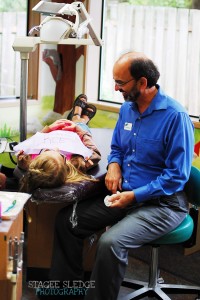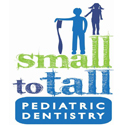Submitted by Dr. Greg Psaltis, Small to Tall Pediatric Dentistry

Many parents are curious about the best time to start dental visits for their young children. Most are surprised to learn that the best time is when the child’s first tooth erupts or, alternatively, no later than 12 months of age.
It has already been several years since the American Academy of Pediatric Dentistry advocated this guideline, but some parents remain unaware of it. In our practice, we are seeing a significant upswing of patients coming in for these initial visits, which are important for three principal reasons:
- To ensure that the child is seen before any disease processes are underway
- To counsel the parent about preventive measures that are particularly critical during infancy
- To start allowing the child to become accustomed to the dental office
Dental decay is the most common disease process among children in the world. The key word here is “process.” Many factors come into play to make a naturally healthy tooth become decayed and only some of these factors are commonly understood.
The relationship between sugar and decay is one and the importance of brushing and flossing the teeth is the other. However, many other factors are not so well known and often lead to devastating dental problems, some requiring that 2 and 3 year old children must be put under general anesthesia to have root canals and crowns done on their teeth. When some parents in our practice hear this, they are shocked. Other parents who experience this are also shocked, but are furthermore guilty, frightened and, unfortunately, usually uninformed. What are these lesser-known factors?

- Night-time use of a bottle with anything other than water is directly linked to increased decay process
- Frequency of eating is a significant factor—the more often a child feeds, the more likely she/he will get cavities
- Cleaning after every feeding is critical—even night-time nursing sessions
- Young tooth enamel is more susceptible to decaying
- Bacteria that create dental decay can be passed between the parents and the child by use of a common utensil (spoon, tippy-cup, etc)
- Use of controlled doses of fluoride on toothpaste protects teeth
- Risk assessment for a child can individualize a preventive plan
- Children’s lifetime dietary patterns are usually established by age one
- Colonization of decay-forming bacteria begins as soon as teeth are present
- Application of a topical fluoride varnish can help prevent decay
I have rarely met the parent whose child is in need of substantial dental treatment who wouldn’t have wanted these pieces of information. The famous axiom of “an ounce of prevention prevents a pound of cure” is particularly apt for the dental health of children. Once a parent understands all the factors in the decay process, it becomes easier to address oral hygiene in a meaningful way.
In addition to the decay process, another important piece of information can help the parents to minimize the risk of dental trauma. The most common reason for dental trauma is due to falls. Sometimes these injuries are minimal, but if the child has a toothbrush, pacifier or toy in his/her mouth, the injury may be significant.
Last of all, non-nutritive oral habits can be discussed at this early age as well. While specific steps to alter (or cease) the habits are not taken at this point, it is good for the parent to understand how thumb-sucking, pacifiers, tongue-thrusting or other oral habits can alter the structure of the teeth and bones of a child. Usually intervention would begin at a later age.
Pediatricians, who have also been trained in the importance of early dental visits, are now referring many of our young patients. Nobody questions the importance of the well-baby check with a pediatrician. Now the realization that a “well-baby” dental appointment is upon us.
Our experience at Small to Tall Pediatric Dentistry has been that children who come in to our practice at an early age (6-12 months) seem to be able to have “regular” dental care (examinations, cleanings, and occasionally x-rays) taken at an earlier age than children who come for an initial visit at age 3-4 years.
Most important, though, is the fact that these children have well-informed parents so that the preventive care can begin almost simultaneously with the arrival of the first teeth. Ultimately, this is the purpose of the early dental appointment. In our practice we have more than enough teeth to fill, cap or extract. It is our desire to reduce that and instead be able to perform in the role of maintaining a child’s excellent oral health.
 Small to Tall Pediatric Dentistry
Small to Tall Pediatric Dentistry
222 Lilly Road NE
Olympia, WA 98506
360.459.5885




















































